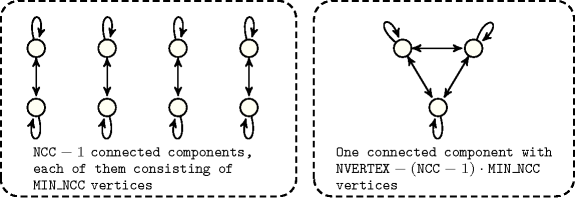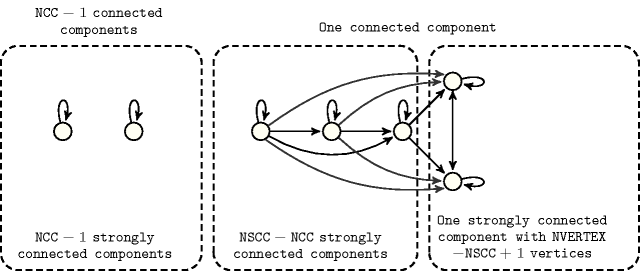4.3.4.4. four parameters/one final graph
Proposition 110 Let denote .
Proof 110 We construct connected components with vertices and one connected component with vertices. corresponds to the maximum number of arcs in a connected component. , , , , , , , and respectively correspond to the maximum number of arcs in a connected component of vertices according to the fact that we use the arc generator , , or .
Proposition 111
Proof 111 (165) We construct connected components with vertices and one connected component with vertices. The quantity corresponds to the minimum number of arcs in a connected component of vertices.
Proposition 112
Proposition 113
Proposition 114
Proof 114 Since a connected component contains at most vertices and since it does not contain any isolated vertex and since a same vertex cannot be both a sink and a source a connected component involves at most sinks and sources all together. Thus the result follows.
Proposition 115
Proof 115 We assume that we have at least two strongly connected components (the case with one being obvious). Let be the family of strongly connected components of . Then , where is the number of arcs between the distinct strongly connected components of . For any strongly connected component the number of arcs it has with the other strongly connected components is bounded by . Consequently, . W.l.o.g. we assume . Then we get .
Proposition 116
Proof 116 Let be the family of strongly connected components of , as , we obtain the result since in a strongly connected graph the number of edges is at least its number of vertices.
Proposition 117
Proposition 118
Proposition 119 Let , and respectively denote , and .
Figure 4.3.7. Illustration of Proposition 119(174). Graph that achieves the maximum number of arcs according to a minimum number of vertices in a connected component, to a number of connected components, as well as to a fixed number of vertices ()

Proof 119 For proving inequality 174 we proceed by induction on the number of vertices of . First note that if all the connected components are reduced to one element the result is obvious. Thus we assume that the number of vertices in the maximal sized connected component of is at least 2. Let be an element of the maximal sized connected component of . Then, satisfies , and . Since by induction hypothesis , and since the number of arcs of incident to is at most , we have that . And thus the result follows.
Proposition 120
Figure 4.3.8. Illustration of Proposition 120. A graph that achieves the maximum number of arcs according to a fixed number of connected components, to a fixed number of strongly connected components as well as to a fixed number of vertices ()

Proof 120 We proceed by induction on , where is any connected component of of maximum cardinality. For then either and thus the formula is clearly true, by Proposition 145 or all the connected components of , but possibly , are reduced to one element. Since isolated vertices are not allowed, again by Proposition 145 applied on , the formula holds indeed and .
Assume that . Then there exists , a connected component of distinct from , with more than one vertex.
Firstly assume that is strongly connected. Let and let be the graph such that and is defined by:
For all connected components of distinct from and we have .
With and , we have , .
Clearly we have that and since , the difference is positive or null. Now as , , (since is strongly connected because and since the reduced graph of the strongly connected components of is exactly the reduced graph of the strongly connected components of to which a unique source has been added) and as , the result holds by induction hypothesis.
Secondly assume that is not strongly connected. Let such that is a strongly connected component of corresponding to a source in the reduced graph of the strongly connected components of . Let be the graph such that and is defined by:
For all connected components of distinct from and we have .
With and , we have if and if . .
Clearly we have that and since , the difference is strictly positive. Now as , , and as , the result holds by induction hypothesis.
Proposition 121
Proof 121 We prove that the invariant is valid for any digraph . First notice that for an operational behaviour, since we cannot assume that Proposition 55 (i.e., ) was already triggered, we use the operator. But since any strongly connected component is connected, then is never negative. Consequently we only show by induction on that . To begin notice that if is a strongly (non void) connected component then either or and in this latter case we have that both and is strictly included in a connected component of (recall that isolated vertices are not allowed). Thus we can directly assume that .
First, consider that there exists a connected component of , say , which is also strongly connected. Let , consequently we have , , , and . Then and thus , which immediately gives the result.
Second consider that any strongly connected component is strictly included in a connected component of . Then, either there exists a strongly connected component such that . Let , consequently we have , , , and . Then and thus , which immediately gives the result. Or, all the strongly connected components are reduced to one element, so we have , and thus we obtain that , which gives the result by for example Proposition 99 (143).
This bound is tight: take for example any circuit.
Proposition 122
Proof 122 Since the maximum number of arcs of a digraph is , and since:
No vertex can have a source as a successor we lose arcs,
No sink can have a successor we lose arcs.
In these two sets of arcs we count twice the arcs from the sinks to the sources, so we finally get a maximum number of arcs corresponding to the right-hand side of the inequality to prove.